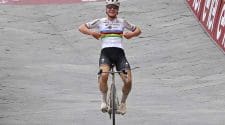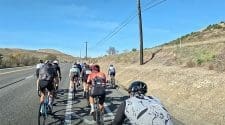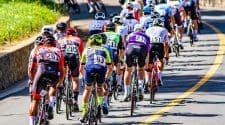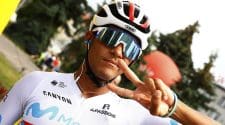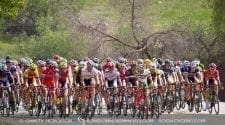To say the 2013 season for the UnitedHealthcare Pro Cycling Team has been anything less than stellar would be an understatement. The results the third-year pro continental squad has produced this season have been impressive, with 35 wins, 83 podiums and more than 160 top-10 performances to its credit through late July 2013. And the depth of the squad is apparent, as more than half of the team’s 22 riders have reached the podium.
The team has enjoyed a tremendous amount of success this year, both in U.S. criterium racing as well as the stage races in which it has competed. Should the ever-consistent podium-topping bunch that is most commonly referred to as the UnitedHealthcare “Blue Train” continue on its current trajectory, the boys could very well earn the title of best criterium squad assembled in U.S. racing history.
Recently, the team’s winning ways have been the subject of articles in leading cycling trade publications, Cyclingnews.com and Velo News, where General Manager and Team Director, Mike Tamayo, talked about his squad’s penchant for podium appearances, what went into pulling this select group of riders together, and what it takes to achieve sustained success at this level.
So what exactly does it take to build such a powerful human-powered locomotive?
Wesley Mallette, UnitedHealthcare Pro Cycling Team VP Communications & Events, sat down with the laser-focused Tamayo to find out and the veteran director shared some of what it takes to build a juggernaut on the American racing circuit and a strong podium contender on the global stage.
Here’s what he had to say:
Q: Wesley Mallette
Mike, the team is doing very well this year with criterium racing in the U.S. as well as stage racing domestically and internationally. Specific to the criteriums, what is the difference in the group of riders you selected this year versus previous years?
A: Mike Tamayo
For starters, we hired of a dedicated group of riders focused solely on being the best criterium racers in the United States. That focus and strategy has resulted in great results on the U.S. criterium-racing calendar so far.
When I was hiring riders for the season and I knew we were looking at a calendar that included more than 25 criteriums in the United States, I realized that equates to 25 plus days of racing. That also means 25 opportunities for potential injury and with a schedule like that, you need to make sure you have multiple options and significant depth on your team.
If you put all your eggs in one basket with one rider, there’s a chance that if that rider gets hurt, your entire season goes down with that one rider. So, when we were picking athletes, we took into consideration the importance of having two or three athletes who could win on any given day. That would give us multiple options – just in case something happened.
We’ve been pretty fortunate this season and we have a healthy group of focused riders who are racing so well together. That’s a big part of the reason why you’re seeing them get first, second and/or third place. They are also selfless and that’s why you’re also seeing them share the wins as well.
Q: Wesley Mallette
So what is your approach to hiring riders? What do you look for?
A: Mike Tamayo
One of the most important things for us is that we have to hire good riders. Once you bring on your 15-20 guys for the year, that’s what you’ve got. So if you make bad decisions in August – October, those decisions will haunt you for the next 12 months.
When I’m hiring the riders and sitting in a meeting discussing with those athletes how we’re going to win a bike race, I’m looking for something that you cannot necessarily measure. It is something that is not quantifiable. It is just a feeling with the group of riders that plays into team spirit and a willingness to be selfless when it comes to one another, regardless of who is the victor on any given night.
That’s really what it comes down to. Athletes who understand the importance of true teamwork, the role they play, and the ability to be selfless and focused on the team objective.
There are a lot of points during a race where I have to make tough decisions, like how far do we let a breakaway go and do we ride for this rider or that rider. As a director, I’m essentially determining if a rider gets a chance to stand on the podium. I have to be able to make those decisions confidently and know that the guys racing believe in my decision. They have to believe and buy in to our approach if we’re going to be successful.
This is about teamwork and the spirit of the Blue Train and wearing the blue jersey is more important than any one rider standing on top of the podium.
Q: Wesley Mallette
Chemistry. It is essential to building successful teams. How important is chemistry with an elite group of athletes like this?
A: Mike Tamayo
During the season, you have to have something that glues the guys together and they need to gel. A lot of times I see that glue for us is a strong, quality staff. I think the staff (i.e., mechanics, soigneurs, transportation director, etc.) helps keep the team together as one unit that believes in what we’re doing. Your staff is your foundation for the team.
The key for us is finding the right people that fit what our program is about. The ability to produce as a rider is important, but we have more than just racing obligations. We have sponsors that we do a lot of events with that are equally important to them when it comes to how they evaluate the value of the partnership. So it is incumbent upon us to work together with them and balance our racing and off the bike activity so everyone wins.
Q: Wesley Mallette
The team is gaining a lot of experience racing internationally. How has that experience helped the riders in their overall development as well as their return to racing in the U.S.?
A: Mike Tamayo
The racing overseas is a little bit harder and longer, so our riders are being constantly taxed when racing outside of the U.S. The competition, distances, speed, etc., are all one-step up. If your baseline as an athlete is able to handle that, then when you come back to U.S. bike racing and the race is just a little bit easier and just a little bit shorter, then you’re in a position to be just that much better.
Q: Wesley Mallette
The ability to adjust to adverse situations in sport is critical to winning. But unlike other sports, there is no “halftime” and there are no “time outs” in pro cycling to give you an opportunity to call your athletes over to the sideline or bench and talk it over. So how do you communicate with the riders during a crit while the race is going on?
A: Mike Tamayo
You’re right. In other sports, you do have a timeout. You have the ability to stop the clock and take a minute to make a decision. In a criterium, normally the riders come by every minute and 15 seconds to minute and a half. So, when I see the riders go by and I don’t like the situation, I have one minute to assess the situation, make the decision and find a way to communicate it to the riders. In many cases, there are simple hand signs that we have developed that we already know. In other situations it can be more complicated because in bike racing you have 120 racers and you only have one winner. So, situations come up that you didn’t talk about and didn’t prepare for and when they come up, it requires you being a bit creative and that’s when you have to rely on your team captain.
Hilton Clarke is our captain and he and I have developed a relationship over the years where he can look at me and I can look at him and with a simple head nod, we both know exactly what the other is thinking.
The more we do this together, the better we get at it and with Hilton, we’ve been at this for four years.
Q: Wesley Mallette
So when something goes awry in the race – especially late in the race – how do you adjust on the fly?
A: Mike Tamayo
We have had things go wrong and every situation is different. For example, if there is a crash and a rider goes down and gets hurt, or if there is a breakaway that shakes out the way that it does, you have to be able to read the situation quickly and then make a call as the director and communicate that to the riders. Sometimes it is heat of the moment and it happens fast and you hope that you are reading the race the right way, and you make the call and move forward.
Q: Wesley Mallette
Talk about the competition domestically. The team has been fairly dominant this season and other teams are racing you even harder. What things are you seeing and how are you adjusting week-to-week?
A: Mike Tamayo
Team SmartStop presented by Mountain Khakis has taken us on head-to-head and their team is getting better every week. Jamis-Hagens Berman and Predator are also both very tough. We have a ton of respect for the competition. These are solid teams with very strong riders and these guys are all getting better every week.
This is all good for U.S. racing. The thing we’re seeing is that when you have a team that is starting to dominate, one of two things will happen – either teams give up and walk away, or teams step up and fight hard and essentially become a better team. And that’s exactly what’s happening. Our competition is racing us better, stronger and faster with every race. We’re going to do our best to keep things going, but these teams are on our heels. We have a lot of respect for them and they are coming up on us.
Q: Wesley Mallette
What is the atmosphere like between the different teams – before and after the races?
A: Mike Tamayo
There is a healthy level of respect. We’re all competitors and you can see the respect between the riders before and after the races. There are a core group of guys that can win and as teams get better, they gain confidence and you can see it in everything they do – from the way they race, to the way they walk before and after the race.
Q: Wesley Mallette
Many people may not realize how much of a team sport cycling truly is. You talk often about the guys racing as one unit. What does it take for those 5-8 guys racing to put one rider on the podium?
A: Mike Tamayo
Think of NASCAR. The drafting is the most important part. If you take the pole position from the gun, from the beginning, then you’re going to run out of fuel and you’re not going to make it to the finish line. That’s where drafting comes into play. The cars swap off and it is the same thing with the riders.
The difference is in cycling you have teammates that can help you fight in the wind and that’s really the most important part. If you have someone from another team try and get away, you have someone from your team chase him down for you, allowing you to work 30% less by sitting behind him. So, at the end of the day, you end up with several guys sacrificing themselves for one guy to win the race.
Photo by Jonathan Devich, epicimages.us









